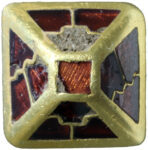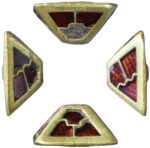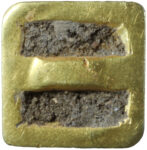 An Early Anglo-Saxon pyramidal mount with cloisonné inlay garnets has been discovered in the Breckland area of Norfolk by a metal detectorist. The rare object dates to between about 560 and 630 A.D., when the counties of Norfolk and Suffolk formed the independent Kingdom of East Anglia in the aftermath of the Anglo-Saxon settlement of Britain.
An Early Anglo-Saxon pyramidal mount with cloisonné inlay garnets has been discovered in the Breckland area of Norfolk by a metal detectorist. The rare object dates to between about 560 and 630 A.D., when the counties of Norfolk and Suffolk formed the independent Kingdom of East Anglia in the aftermath of the Anglo-Saxon settlement of Britain.
A petite piece at 12mm x 11.9mm (0.4in x 0.4in), the gold pyramid has a square base and is inlaid on all four sides with three cloisonné garnets in two different styles on opposite sides: a stepped t-shape and a diagonal t  with a wavy crossbar. The pyramid has a flat square top with a single cloisonné garnet. The borders between the pyramid’s facets are much thicker than the slim lines that divide the cells on the sides. The garnets have waffle-pattern foil backing, a technique often seen in Anglo-Saxon jewelry (e.g., the Staffordshire Hoard). One of the garnets on the side is missing and some of the others have suffered cracking and chipping. They are all of either Indian or Sri Lankan origin. Under the base of the pyramid is a slightly convex crossing the middle. The inside of the pyramid is hollow and currently full of soil.
with a wavy crossbar. The pyramid has a flat square top with a single cloisonné garnet. The borders between the pyramid’s facets are much thicker than the slim lines that divide the cells on the sides. The garnets have waffle-pattern foil backing, a technique often seen in Anglo-Saxon jewelry (e.g., the Staffordshire Hoard). One of the garnets on the side is missing and some of the others have suffered cracking and chipping. They are all of either Indian or Sri Lankan origin. Under the base of the pyramid is a slightly convex crossing the middle. The inside of the pyramid is hollow and currently full of soil.
[Finds liaison officer Helen] Geake said: “It would have been owned by somebody in the entourage of a great lord or Anglo-Saxon king, and he would have been a lord or king who might have found his way into the history books.
“They or their lord had access to gold and garnets and to high craftsmanship.”
 While Anglo-Saxon pyramidal mounts have been found before — primarily as one-off finds rather than in a funerary context — it’s not entirely clear what their function was or where exactly they were mounted. The bar crossing the underside suggests it may have been a scabbard mount, used to secure the sword into the scabbard by threading the strap through the bar on the base of the pyramid
While Anglo-Saxon pyramidal mounts have been found before — primarily as one-off finds rather than in a funerary context — it’s not entirely clear what their function was or where exactly they were mounted. The bar crossing the underside suggests it may have been a scabbard mount, used to secure the sword into the scabbard by threading the strap through the bar on the base of the pyramid
Pyramidal mounts were created and used from the late 6th century until the early 8th. They went from short, squat pyramids on square bases to taller, slimmer versions with a variety of shapes including circular, hexagonal and octagonal. The recently-discovered example is from the early period.
Those crazy “stepped t-shapes with wavy crossbars” might once have been Saxon “Irminsuls”.
An “Irminsul” (‘great pillar’) was a sacred pillar-like object attested as playing an important role in Saxon paganism. Medieval sources describe how an Irminsul was destroyed by Charlemagne during the Saxon Wars, and how he carried away gold and silver from there. A column is is in German referred to as “Säule”.
upload.wikimedia.org/wikipedia/commons/a/ae/Hamersleben_2014_0010.jpg
upload.wikimedia.org/wikipedia/commons/f/f7/Hamersleben_2014_0012.jpg
upload.wikimedia.org/wikipedia/commons/a/a9/Marsberg-Obermarsberg_Sauerland_Ost_498_pk.jpg
:hattip:
—-
[772AD] DCCLXXII. Tunc domnus Carolus mitissimus rex sinodum tenuit ad Warmatiam. Et inde perrexit partibus Saxoniae prima vice, Eresburgum castrum [i.e. Obermarsberg] coepit, ad Ermensul usque pervenit et ipsum fanum destruxit et aurum vel argentum, quod ibi repperit, abstulit. Et fuit siccitas magna, ita ut aqua deficeret in supradicto loco, ubi Ermensul stabat; et dum voluit ibi duos aut tres praedictus gloriosus rex stare dies fanum ipsum ad perdestruendum et aquam non haberent, tunc subito divina largiente gratia media die cuncto exercitu quiescente in quodam torrente omnibus hominibus ignorantibus aquae effusae sunt largissimae, ita ut cunctus exercitus sufficienter haberet. Tunc super Wisoram fluvium venit suprascriptus magnus rex et ibi cum Saxonibus placitum habuit et recepit obsides XII et reversus est in Franciam.
—-
1st visit. Well done. My Latin’s rotten but my interest is sincere. We’ll be back
I hope I’m not the only one thinking about Sutton Hoo:
https://www.britishmuseum.org/collection/object/H_1939-1010-28
I hope everyone is thinking about Sutton Hoo and other hoards. Several examples of pyramidal gold and garnet finds from that era.
…and maybe also, of the “Staffordshire Hoard” of almost 4,600 items and metal fragments, amounting to a total of 5.1 kg (11 lb) of gold, 1.4 kg (3 lb) of silver and likewise some 3,500 pieces of garnet cloisonné jewellery, e.g.:
upload.wikimedia.org/wikipedia/commons/6/68/Staffordshire_Hoard_Pommel_Caps.jpg
Rædwald’s 7th century grave goods from that burial mound in Sutton Hoo are of course exquisite.
Particularly Saxon are maybe mainly the proposed “Irminsuls”, as there is e.g.:
——-
(a) Frankish (from the tomb of Childeric I, 481AD –father of Clovis I and son of Merovech, the ‘Merovingian’ dynast – “[Discovered in 1653] On the night of November 5–6, 1831, the treasure of Childeric was among 80 kg of treasure stolen from the Library and melted down for the gold”.)
upload.wikimedia.org/wikipedia/commons/2/2f/Abeilles_de_Childéric_Ier.jpg
upload.wikimedia.org/wikipedia/commons/9/91/Scramasaxe_de_Childéric_Ier.jpg
Also, (more low-key) from ca. 500AD, e.g.: upload.wikimedia.org/wikipedia/commons/f/fa/Almandinscheibe_1a.jpg
——-
(b) Gothic Birds (some without garnet):
upload.wikimedia.org/wikipedia/commons/8/87/Fibula_a_forma_d’aquila,_arte_ostrogota_da_domagnano_(s._marino),_500_ca.JPG
de.wikipedia.org/wiki/Datei:Fíbula_aquiliforme_(M.A.N._Madrid)_01.jpg
And from 1965 in Thuringia, i.e. the grave of the “girl from Oßmannstedt” (notably, not the 5th century garnet orignal):
upload.wikimedia.org/wikipedia/commons/d/dc/Adlerfibel_Oßmannstedt.JPG